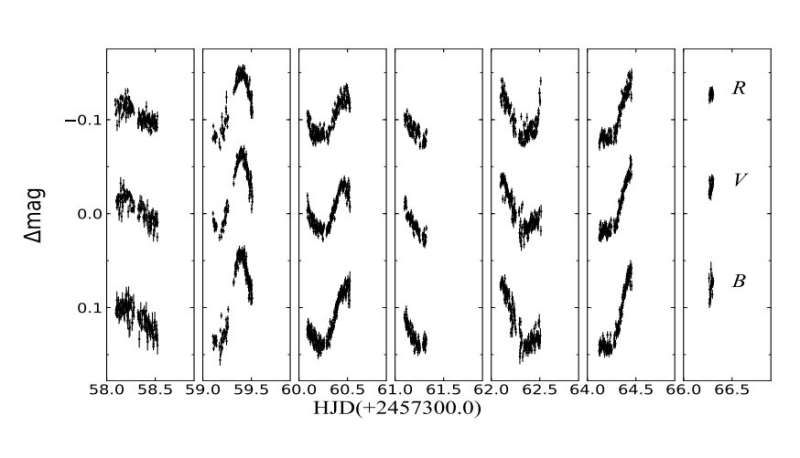September 21, 2020 report
Almost a dozen new variable stars detected in the open cluster NGC 1912 and its surroundings

Chinese astronomers have conducted a study of variable stars in the galactic open cluster NGC 1912 and its surrounding field, detecting 11 new variables in this cluster, including binary systems. The study was detailed in a research paper published September 11 on the arXiv pre-print repository.
Star clusters offer excellent opportunities to study stellar evolution, as they are collections of stars with similar properties, for instance age, distance and initial composition. In particular, astronomers often search for variable stars in young clusters, which could be crucial in advancing the understanding of pre-main-sequence (PMS) stars, and therefore the initial phases of stellar evolution.
Estimated to be about 300 million years old, NGC 1912 (also known as Messier 38) is an open cluster located some 3,200 light years away, in the anti-center direction of our Milky Way galaxy. So far, over 800 member stars of this cluster have been identified, which includes at least 20 variables of different types such as Delta Scuti, Gamma Doradus, and also eclipsing binaries (EBs).
Now, a team of astronomers led by Chunyan Li of the Chinese Academy of Sciences (CAS) reports the discovery of 11 new variable stars in NGC 1912 based on observations performed with the Nanshan 1-m telescope (NOWT) of the Xinjiang Astronomical Observatory. To confirm the membership of the newly found objects, they used the Unsupervised Photometric Membership Assignment in Stellar Clusters (UPMASK) method and data from ESA's Gaia satellite.
"We investigated and characterized the variable stars in the open cluster NGC 1912 and its surrounding field by photometric observations," the astronomers wrote in the paper.
Out of the 11 newly detected variables, six are Gamma Doradus stars, one is a Delta Scuti star, three are detached binaries and one was classified as a contact binary. Additionally, the study also detected 13 previously known variable stars in NGC 1912.
The newfound variables have mean instrumental magnitudes in the V band ranging from 15.0 to 18.62 mag, and amplitudes of folded light curves in V band between 0.01 and 1.5. The periods of these stars were measured to be within the range of 0.11 to 2.56 days.
One of the newfound variables, a Gamma Doradus star designated V4, was confirmed to be the member of NGC 1912. The cluster membership probability of two other Gamma Doradus stars, V3 and V5, was estimated to be 50 and 80 percent. The membership of the remaining eight variables is still highly uncertain.
The astronomers added that further studies are needed to uncover more insights into the properties of the newly detected variables and to finally confirm their cluster membership. In particular, more data from NASA's Transiting Exoplanet Survey Satellite (TESS) could help us better understand the nature of variable stars in NGC 1912.
More information: Li et al., Investigating Variable Stars in the Open Cluster NGC 1912 and Its Surrounding Field, arXiv:2009.05492 [astro-ph.SR] arxiv.org/abs/2009.05492
© 2020 Science X Network





















